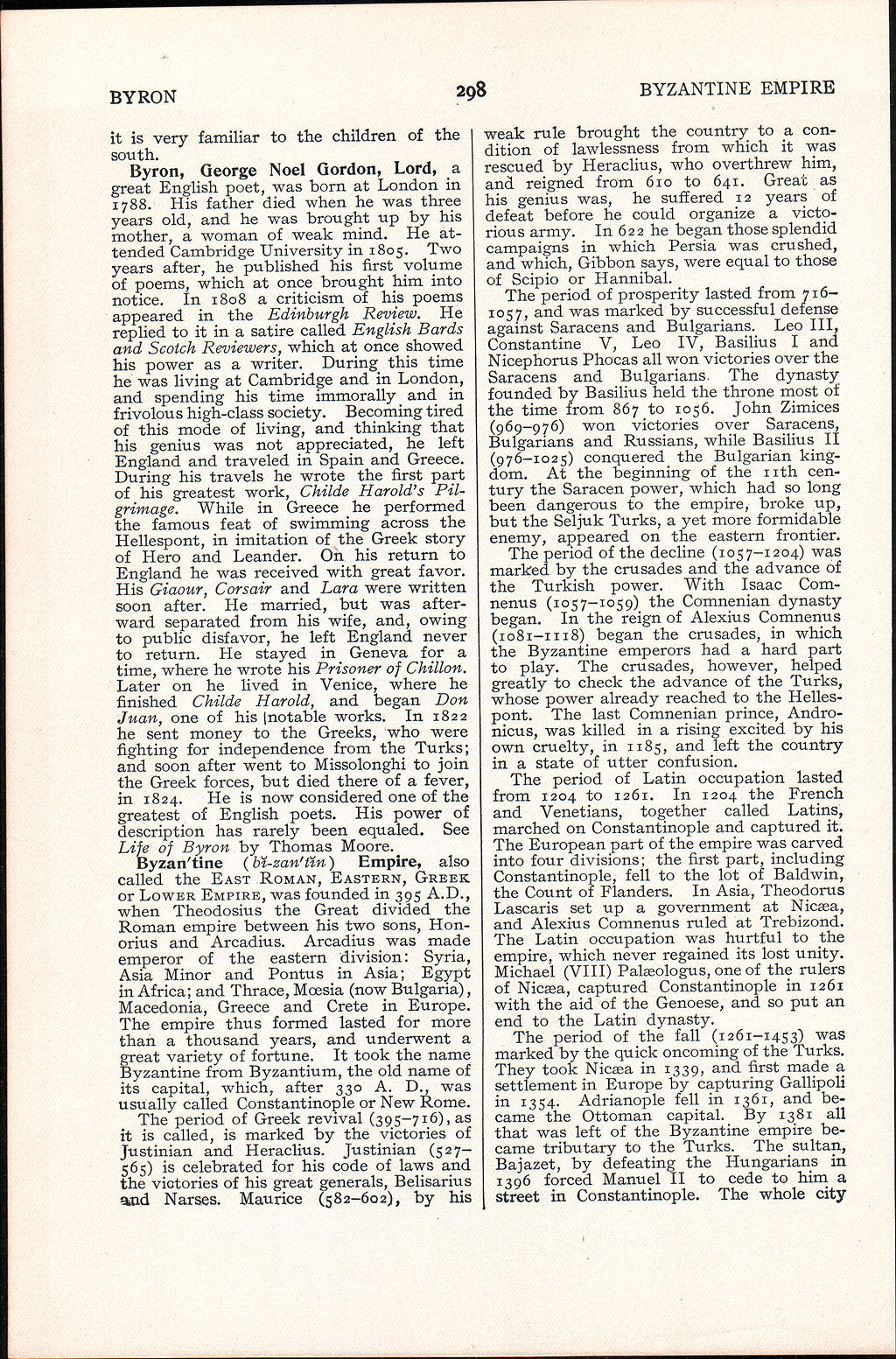Page 298 : BYRON — BYZANTINE EMPIRE
Individual articles:
it is very familiar to the children of the south.
Byron, George Noel Gordon, Lord, a great English poet, was born at London in 1788. His father died when he was three years old, and he was brought up by his mother, a woman of weak mind. He attended Cambridge University in 1805. Two years after, he published his first volume of poems, which at once brought him into notice. In 1808 a criticism of his poems appeared in the Edinburgh Review. He replied to it in a satire called English Bards and Scotch Reviewers, which at once showed his power as a writer. During this time he was living at Cambridge and in London, and spending his time immorally and in frivolous high-class society. Becoming tired of this mode of living, and thinking that his genius was not appreciated, he left England and traveled in Spain and Greece. During his travels he wrote the first part of his greatest work, Childe Harold’s Pilgrimage. While in Greece he performed the famous feat of swimming across the Hellespont, in imitation of the Greek story of Hero and Leander. On his return to England he was received with great favor. His Giaour, Corsair and Lara were written soon after. He married, but was afterward separated from his wife, and, owing to public disfavor, he left England never to return. He stayed in Geneva for a time, where he wrote his Prisoner of Chillon. Later on he lived in Venice, where he finished Childe Harold, and began Don Juan, one of his notable works. In 1822 he sent money to the Greeks, who were fighting for independence from the Turks; and soon after went to Missolonghi to join the Greek forces, but died there of a fever, in 1824. He is now considered one of the greatest of English poets. His power of description has rarely been equaled. See Life of Byron by Thomas Moore.
Byzan′tine (bĭ-zan′tĭn) Empire, also called the East Roman, Eastern, Greek or Lower Empire, was founded in 395 A. D., when Theodosius the Great divided the Roman empire between his two sons, Honorius and Arcadius. Arcadius was made emperor of the eastern division: Syria, Asia Minor and Pontus in Asia; Egypt in Africa; and Thrace, Mœsia (now Bulgaria), Macedonia, Greece and Crete in Europe. The empire thus formed lasted for more than a thousand years, and underwent a great variety of fortune. It took the name Byzantine from Byzantium, the old name of its capital, which, after 330 A. D., was usually called Constantinople or New Rome.
The period of Greek revival (395–716), as it is called, is marked by the victories of Justinian and Heraclius. Justinian (527–565) is celebrated for his code of laws and the victories of his great generals, Belisarius and Narses. Maurice (582–602), by his weak rule brought the country to a condition of lawlessness from which it was rescued by Heraclius, who overthrew him, and reigned from 610 to 641. Great as his genius was, he suffered 12 years of defeat before he could organize a victorious army. In 622 he began those splendid campaigns in which Persia was crushed, and which, Gibbon says, were equal to those of Scipio or Hannibal.
The period of prosperity lasted from 716–1057, and was marked by successful defense against Saracens and Bulgarians. Leo III, Constantine V, Leo IV, Basilius I and Nicephorus Phocas all won victories over the Saracens and Bulgarians. The dynasty founded by Basilius held the throne most of the time from 867 to 1056. John Zimices (969—976) won victories over Saracens, Bulgarians and Russians, while Basilius II (976—1025) conquered the Bulgarian kingdom. At the beginning of the nth century the Saracen power, which had so long been dangerous to the empire, broke up, but the Seljuk Turks, a yet more formidable enemy, appeared on the eastern frontier.
The period of the decline (1057–1204) was marked by the crusades and the advance of the Turkish power. With Isaac Comnenus (1057–1059) the Comnenian dynasty began. In the reign of Alexius Comnenus (1081–1118) began the crusades, in which the Byzantine emperors had a hard part to play. The crusades, however, helped greatly to check the advance of the Turks, whose power already reached to the Hellespont. The last Comnenian prince, Andronicus, was killed in a rising excited by his own cruelty, in 1185, and left the country in a state of utter confusion.
The period of Latin occupation lasted from 1204 to 1261. In 1204 the French and Venetians, together called Latins, marched on Constantinople and captured it. The European part of the empire was carved into four divisions; the first part, including Constantinople, fell to the lot of Baldwin, the Count of Flanders. In Asia, Theodoras Lascaris set up a government at Nicæa, and Alexius Comnenus ruled at Trebizond. The Latin occupation was hurtful to the empire, which never regained its lost unity. Michael (VIII) Palæologus, one of the rulers of Nicæa, captured Constantinople in 1261 with the aid of the Genoese, and so put an end to the Latin dynasty.
The period of the fall (1261–1453) was marked by the quick oncoming of the Turks. They took Nicæa in 1339, and first made a settlement in Europe by capturing Gallipoli in 1354. Adrianople fell in 1361, and became the Ottoman capital. By 1381 all that was left of the Byzantine empire became tributary to the Turks. The sultan, Bajazet, by defeating the Hungarians in 1396 forced Manuel II to cede to him a street in Constantinople. The whole city
